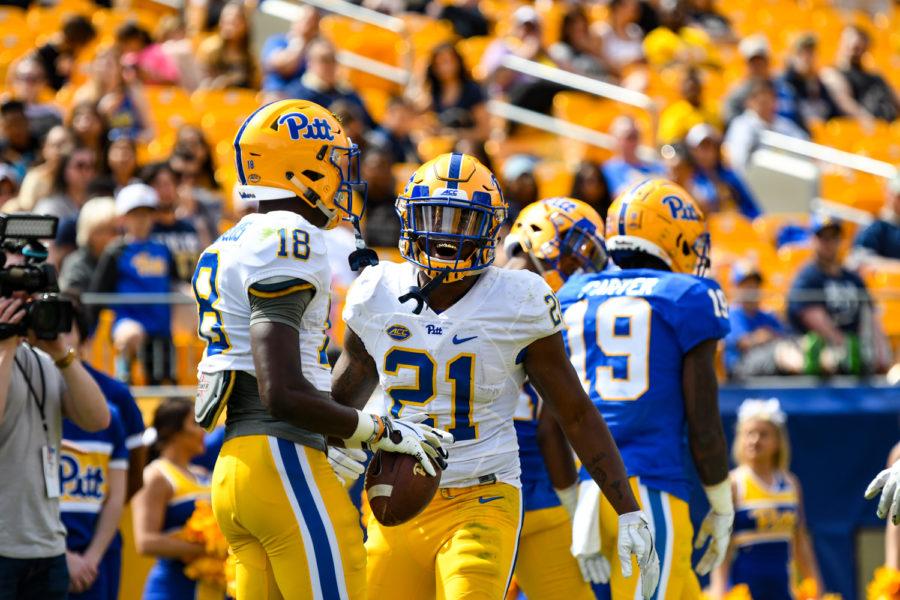3 takeaways from Pitt’s Blue-Gold Game
Bader Abdulmajeed | Senior Staff Photographer
Junior running back A. J. Davis (21) and sophomore wide receiver Shocky Jacques-Louis (18) celebrate during Pitt’s spring Blue-Gold game on Saturday.
April 15, 2019
Pitt football gave the public a glimpse at its team for the upcoming season in Saturday’s annual Blue-Gold Spring Game, a pseudo-scrimmage that involved four quarters and 11-on-11 action, though the quarters were five minutes shorter and the quarterbacks wore red to ward off contact from defenders. The Blue team, led by incumbent starter and rising junior quarterback Kenny Pickett, won 14-10 thanks to two third-quarter touchdown connections from Pickett to redshirt senior wideout Tre Tipton.
When it comes to spring game analysis, there are two extreme schools of thought. The first is to treat it like a glorified game of two-hand touch, to dismiss it as another spring practice still several months removed from real-game action that indicates little to nothing about the upcoming season. The second is to become so caught up in the game uniforms and public spectacle of the event that you convince yourself that some walk-on Joe Schmo is the next Heisman winner because he torched the third string defense during a couple junk-time possessions in the fourth quarter.
The reality of the spring game lies somewhere in between. Sure, it’s a laid-back intrasquad run-through, but it can still be used to showcase certain players primed to break out in the fall, or provide a glimpse at the team’s identity for the upcoming season. Take last year’s game, for example, when the two squads combined for 8 yards rushing in a 10-3 defensive battle. The rushing yards were deceiving for a unit that finished 16th out of 130 teams, but the game served as an accurate harbinger for a Panther team that struggled to score (86th in points per game) while succeeding with a sound defense (59th in yards allowed per game).
With that being said, Saturday’s game provided plenty to talk about. Let’s unpack which performances could indicate things to come, and debunk those that are too good — or too bad — to be true.
What’s up with the run game?
The Blue team, led in the backfield by redshirt sophomore running back Todd Sibley Jr. and sophomore back V’Lique Carter, had a tough time running the ball. Sibley led the way with five yards on four carries, while the unit as a whole rushed for an abysmal -12 yards.
What’s worse, though, is that the Blue team somehow out-rushed its opponent on the day. Gold rushed for -20 yards thanks to a series of sacks taken by first-year quarterback Davis Beville and redshirt freshman quarterback Nick Patti. Junior tailback A.J. Davis served as the workhorse with nine carries, but picked up only 6 yards.
So, what gives? Pitt is supposed to be Running Back University, and the standard is higher than ever after the Panthers averaged a hefty 227.2 rush yards per game last season. How can these guys move the ball against top-notch ACC competition if they can’t even break the line of scrimmage against a hodgepodge opposition of backups and starters?
In the words of Green Bay Packers quarterback Aaron Rodgers, people need to “relax” when it comes to making snap judgments on Pitt’s ground game. In a half-organized scrimmage of this nature, it’s easier to play defense than offense, hence why the games tend to be low-scoring and unsightly. Communication and continuity are key for any offensive line, and the spring game draft system breaks up the starting unit into fragments, resulting in disjointed offensive line combinations that struggle to keep the defense out of the backfield.
“It’s hard for a broken O-line to run the ball,” redshirt junior defensive lineman Rashad Weaver said after the game.
Now, it’s unlikely that Pitt’s backfield will achieve the same level of success as last season, when the senior duo of Qadree Ollison and Darrin Hall each rushed for more than 1,000 yards and made All-ACC Second and Third team, respectively. But the running game is the last thing you should ever worry about on a Pitt football team, and Davis and Carter should be expected to uphold the standard of RBU despite their ugly showing on Saturday.
Mark Whipple, quarterback whisperer
Pitt’s passing problems last season were well documented. The Panthers ranked 123rd out of 130 teams with 139.7 passing yards per game. Those struggles culminated in the ACC Championship, when Pickett threw for just 8 yards in a blowout loss to Clemson. Many called for the job of offensive coordinator Shawn Watson, and their demands were met after he was canned in the offseason.
In stepped new coordinator Mark Whipple, a coach whose resume includes a stint as quarterbacks coach for the Pittsburgh Steelers during their Super Bowl XL season. Despite being 61 years old, Whipple was billed as a fresh, innovative offensive mind with a knack for developing quarterbacks.
Saturday’s game certainly did nothing to dispel Whipple’s reputation, to say the least. Both starting quarterbacks finished with stellar counting stats in limited action — Pickett completed 10 of 14 passes for 125 yards and two touchdowns, while Beville went 13 of 17 for 157 yards and a touchdown. That’s a drastic turnaround from last year’s showing, when Pickett went 13 of 23 and backup quarterback Ricky Town went one of nine.
I’ll stop short of deeming Whipple the next Sean McVay, but it seems safe to say that fans can expect a sizeable improvement over last year’s dreadful passing attack. Pickett looked more comfortable in the pocket than he did at any point last season, likely a testament to the easier timing with receivers allowed by Whipple’s scheme. And Beville looked promising in his own right, showing off a strong arm by completing three passes for 30 or more yards.
V’Lique Carter, two-way superstar
Little-known defensive backup V’Lique Carter broke through in a big way last season against Duke in Week 8, rushing for 137 yards and two touchdowns on seven carries. Originally recruited as a defensive back, the speedy Carter featured in the offense for the rest of the season.
Now a sophomore, Carter is expected to share a heavy workload of Pitt’s offensive production. But in an unexpected twist, he played throughout Saturday’s game on the defensive side as well, accumulating four total tackles.
It’s rare for a college player to see playing time on both sides of the ball, so some might be quick to brush this off as a spring game gimmick. But Narduzzi has shown a willingness in the past to let his athletes play offense and defense. Most recently, Jordan Whitehead — now playing in the NFL for the Tampa Bay Buccaneers — was utilized as both a safety and slot receiver in 2017. Even James Conner played snaps at both running back and defensive end in 2016.
But it’s unlikely that Carter plays significant time on defense once regular season action picks up. Pitt’s defensive backfield is one of its deeper position groups, with several returning veterans like senior Damar Hamlin and redshirt seniors Dane Jackson and Jazzee Stocker. Plus, the offensive backfield is one of Pitt’s shallowest positions, with Carter returning as the group’s leading rusher despite playing limited action last season. There’s simply no need to try and force Carter into playing an extra position — although Narduzzi may still do so sporadically just to utilize his next-level athleticism.








